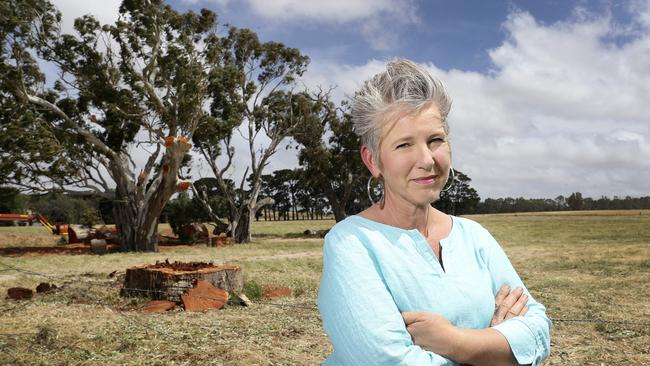Significant tree laws accelerating loss of vegetation say councils who want reform to make it harder to cut down trees
SA’s planning laws are making it easier for developers to destroy trees but the State Government insists there will be no changes to make felling harder for developers.

- Garden guru laments ‘apathy’ over tree ‘sacrifice’
- Latest subscriber exclusive giveaways, specials and prizes
Calls for a strengthening of laws to make it harder for developers and homeowners to cut down mature trees have been ignored as part of statewide planning reforms.
Environmental groups and councils say current legislation has accelerated the felling of trees on private land and is undermining State Government and council efforts to plant more trees to combat increasing urban heat.
But state Planning Minister Stephan Knoll has confirmed there will be no reform of tree legislation.
Conservation SA chief executive Craig Wilkins said increasing urban infill and weak legislation had combined to increase tree destruction.

“Over the past few years there has been a flood of tree loss across the city,” he said.
“It’s a significantly different landscape and that looks like it’s not going to change, in fact it’s probably going to get worse.
“The reality is the loss on private land is simply not possible to make up on public land; there’s simply not enough space to make up the difference.”
The Government wants to increase vegetation on public land by 20 per cent by 2045, requiring councils to plant of tens of thousands of trees each year to help cool neighbourhoods and counter so-called heat island effect.
Submissions to a review of planning regulations have argued that could not be achieved without an overhaul of significant tree legislation in favour of protecting trees on private land.
Among the concerns are that amendments to legislation in 2011 have made it easier to remove trees by:
INCREASING diameter of a tree deemed to be significant from 2m to 3m;
EXPANDING species that can be cut down without approval;
MAKING it easier to remove trees, except for eucalypts and willow myrtles, within 10m of a building or pool and;
ALLOWING automatic removal of any tree within 20m of a building in a medium or high bushfire-risk area.
Resilient East – a partnership of eight eastern suburbs councils – said the 2011 amendments had “dramatically reduced” the ability of regulations to protect trees and had resulted in “excessive removal” of trees.
“ … of more concern, the changes have contributed to an erosion of the value that communities and the development sector place on trees,” it wrote in a submission sent to the State Planning Commission earlier this year.
“Many trees are intergenerational assets, helping to make urban areas desirable places to live and invest as well as providing habitat, urban cooling, shading and a whole range of other ecosystem services.”

Mt Barker Council urban forest officer and Local Government Urban Forest Alliance chair Chris Lawry said those exemptions made the legislation “near worthless” in protecting remnant indigenous trees, trees that have cultural value and protect against habitat loss.
“Should the rate of canopy loss trend continue, the government’s ability to maintain canopy cover or offset this loss on public land will be impossible,” he wrote in a submission to the commission.
“Effective legislation is therefore required to protect those trees on private land that significantly contribute to canopy cover.”
Ratepayers, including Sunday Mail gardening columnist Sophie Thomson, criticised Mt Barker Council this week for removing four centuries-old river red gums for a sports hub.
The council paid $19,623.92 into the Native Vegetation Fund to offset the environmental impact of the tree loss.
In recent years metropolitan councils have reported declining canopy cover, and increasing urban heat, blamed predominantly on impacts of urban renewal increasing hard surfaces and leaving little space for new trees.
HOT PROPERTY: FIND OUT HOW HOT YOUR PROPERTY GETS
Campbelltown Council, undergoing some of the highest rates of urban infill, has experienced a 6.5 per cent loss in canopy cover between 2006 and 2016.
Burnside Council – which has among SA’s highest public tree cover – experienced a 10 per cent canopy decline between 2010 and 2015.

Among questions The Advertiser asked Mr Knoll and environment Minister David Speirs were whether they believe the current legislation needed strengthening, whether it was too easy to cut down trees that may be of high value to the community and if the government intended to review the legislation.
In a two-line emailed response, Mr Knoll – speaking on the Government’s behalf – said the existing policy for regulated and significant trees transition to the new planning and design code.
“That means these trees will have the same level of protection under the code as they do now and any suggestion to the contrary is false,” he said.
The State Planning Commission’s chief Michael Lennon has previously said loss of trees was a major concern raised with his office.
The draft planning and design code – which will replace all development plans from July 2020 – has proposed at least one tree must be planted for each new home.
Conservation SA is hosting a free ‘Who Will Speak For The Trees?’ public forum on November 11 at The Joinery, 111 Franklin St, Adelaide from 6.30pm.
